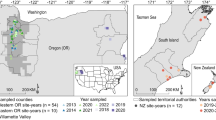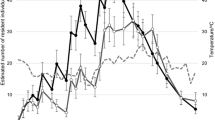Abstract
Ascertaining the relative effects of factors such as weather and predation on population dynamics, and determining the time scales on which they operate, is important to our understanding of basic ecology and pest management. In this study, we sampled the pine engraver Ips pini (Say) (Coleoptera: Scolytidae) and its predominant predators Thanasimus dubius (F.) (Coleoptera: Cleridae) and Platysoma cylindrica (Paykull) (Coleoptera: Histeridae) in red pine plantations in Wisconsin, USA, over 2 years. We sampled both the prey and predators using flight traps baited with the synthetic aggregation pheromone of I. pini. Flight models were constructed using weather variables (temperature and precipitation), counts of bark beetles and their predators, and temporal variables to incorporate possible effects of seasonality. The number of I. pini per weekly collection period was temperature dependent and decreased with the number of predators, specifically T. dubius in 2001 and P. cylindrica in 2002. The number of predators captured each week was also weather dependent. The predators had similar seasonal phenologies, and the number of each predator species was positively correlated with the other. Including a term for the number of prey did not improve the model fits for either predator for either year. Our results suggest that exogenous weather factors strongly affect the flight activity of I. pini, but that its abundance is also affected by direct density-dependent processes acting over weekly time scales. Adult predation during both colonization and dispersal are likely processes yielding these dynamics.



Similar content being viewed by others
References
Akaike H (1973) Information theory and an extension of the maximum likelihood principle. In: Petrov BN, Csadki F (eds) 2nd international symposium on information theory. Akademiai Kiado, Budapest, pp 267–281
Aukema BH, Raffa KF (2002) Relative effects of exophytic predation, endophytic predation, and intraspecific competition on a subcortical herbivore: consequences to the reproduction of Ips pini and Thanasimus dubius. Oecologia 133:483–491
Aukema BH, Raffa KF (2004a) Behavior of adult and larval Platysoma cylindrica (Coleoptera: Histeridae) and larval Medetera bistriata (Diptera: Dolichopodidae) during subcortical predation of Ips pini (Coleoptera: Scolytidae). J Insect Behav 17:115–128
Aukema BH, Raffa KF (2004b) Does aggregation benefit bark beetles by diluting predation? Links between a group-colonization strategy and the absence of emergent multiple predator effects. Ecol Entomol 29:129–138
Aukema BH, Raffa KF (2004c) Gender- and sequence-dependent predation within group colonizers of defended plants: a constraint on cheating among bark beetles? Oecologia 138:253–258
Aukema BH, Dahlsten DL, Raffa KF (2000a) Exploiting behavioral disparities among predators and prey to selectively remove pests: maximizing the ratio of bark beetles to predators removed during semiochemically based trap-out. Environ Entomol 29:651–660
Aukema BH, Dahlsten DL, Raffa KF (2000b) Improved population monitoring of bark beetles and predators by incorporating disparate behavioral responses to semiochemicals. Environ Entomol 29:618–629
Aukema BH, Clayton MK, Raffa KF (2004) Density-dependent effects of multiple predators sharing a common prey in an endophytic habitat. Oecologia 139:418–426
Ayres BD, Ayres MP, Abrahamson MD, Teale SA (2001) Resource partitioning and overlap in three sympatric species of Ips bark beetles (Coleoptera: Scolytidae). Oecologia 128:443–453
Barlow ND, Beggs JR, Barron MC (2002) Dynamics of common wasps in New Zealand beech forests: a model with density dependence and weather. J Anim Ecol 71:663–671
Cappuccino N (1992) Adjacent trophic-level effects on spatial density dependence in a herbivore predator parasitoid system. Ecol Entomol 17:105–108
Clemens WA (1916) The pine bark beetle. Cornell Univ Agric Exp Stn Bull 383:287–298
Cronin JT, Reeve JD, Wilkens R, Turchin P (2000) The pattern and range of movement of a checkered beetle predator relative to its bark beetle prey. Oikos 90:127–138
Denno RF (1994) The evolution of dispersal polymorphisms in insects: the influence of habitats, host plants, and mates. Res Popul Ecol 36:127–135
Erbilgin N, Raffa KF (2001a) Kairomonal range of generalist predators in specialized habitats: responses to multiple phloeophagous species emitting pheromones vs host odors. Entomol Exp Appl 99:205–210
Erbilgin N, Raffa KF (2001b) Modulation of predator attraction to pheromones of two prey species by stereochemistry of plant volatiles. Oecologia 127:444–453
Erbilgin N, Raffa KF (2002) Association of declining red pine stands with reduced populations of bark beetle predators, seasonal increases in root colonizing insects, and incidence of root pathogens. For Ecol Manage 164:221–236
Erbilgin N, Nordheim EV, Aukema BH, Raffa KF (2002) Population dynamics of Ips pini and Ips grandicollis in red pine plantations in Wisconsin: within- and between-year associations with predators, competitors, and habitat quality. Environ Entomol 31:1043–1051
Forsse E, Smith SM, Bourchier RS (1992) Flight initiation in the egg parasitoid Trichogramma minutum: effects of ambient temperature, mates, food, and host eggs. Entomol Exp Appl 62:147–154
Franklin AJ, Grégoire JC (2001) Dose-dependent response and preliminary observations on attraction range of Ips typographus to pheromones at low release rates. J Chem Ecol 27:2425–2435
Goldwasser L, Roughgarden J (1997) Sampling effects and the estimation of food-web properties. Ecology 78:41–54
Graham IM (2002) Estimating weasel Mustela nivalis abundance from tunnel tracking indices at fluctuating field vole Microtus agrestis density. Wildl Biol 8:279–287
Herms DA, Haack RA, Ayres BD (1991) Variation in semiochemical-mediated prey-predator interaction: Ips pini (Scolytidae) and Thanasimus dubius (Cleridae). J Chem Ecol 17:515–524
Ihaka I, Gentleman R (1996) R: a language for data analysis and graphics. J Comput Graph Stat 5:299–314
Jiang L, Shao N (2003) Autocorrelated exogenous factors and the detection of delayed density dependence. Ecology 84:2208–2213
Jonsson P, Anderbrant O (1993) Weather factors influencing catch of Neodiprion sertifer (Hymenoptera, Diprionidae) in pheromone traps. Environ Entomol 22:445–452
Kamata N (2000) Population dynamics of the beech caterpillar, Syntypistis punctatella, and biotic and abiotic factors. Popul Ecol 42:267–278
Kegley SJ, Livingston RL, Gibson KE (1997) Pine engraver, Ips pini, in the western United States. Forest insect and disease leaflet 122. USDA Forest Service, Washington
Klepzig KD, Raffa KF, Smalley EB (1991) Association of insect–fungal complexes with red pine decline in Wisconsin. For Sci 41:1119–1139
Krüger O (2002) Dissecting common buzzard lifespan and lifetime reproductive success: the relative importance of food, competition, weather, habitat and individual attributes. Oecologia 133:474–482
Lehane MJ, Mcewen PK, Whitaker CJ, Schofield CJ (1992) The role of temperature and nutritional status in flight initiation by Triatoma infestans. Acta Trop 52:27–38
Lewellen RH, Vessey SH (1998) The effect of density dependence and weather on population size of a polyvoltine species. Ecol Monogr 68:571–594
Lindgren BS (1983) A multiple-funnel trap for scolytid beetles. Can Entomol 115:299–302
McCambridge WF (1971) Temperature limits of the flight of mountain pine beetle, Dendroctonus ponderosae (Coleoptera: Scolytidae). Ann Entomol Soc Am 64:534–535
Mignot EC, Anderson RF (1969) Bionomics of the bark beetle predator, Thanasimus dubius Fab. (Coleoptera:Cleridae). Entomol News 80:305–310
Miller DR, Gibson KE, Raffa KF, Seybold SJ, Teale SA, Wood DL (1997) Geographic variation in response of pine engraver, Ips pini, and associated species to pheromone, lanierone. J Chem Ecol 23:2013–2031
Moser TC, Dell TR (1979) Predictors of southern flight beetle activity. For Sci 25:217–222
Moser JC, Dell TR (1980) Weather factors predicting flying populations of a clerid predator and its prey, the southern pine beetle. In: Berryman AA, Safranyik L (eds) Proceedings of the 2nd IUFRO conference on dispersal of forest insects: evaluation, theory and management implications. Washington State University, Pullman, Washington, pp 266–278
Östrand F, Anderbrant O (2003) From where are insects recruited? a new model to interpret catches of attractive traps. Agric For Entomol 5:163–171
Pinheiro JC, Bates DM (2002) Mixed-effects models in S and S-Plus. Springer, Berlin Heidelberg New York
Poland TM, Haack RA, Petrice TR (2002) Tomicus piniperda (Coleoptera: Scolytidae) initial flight and shoot departure along a north-south gradient. J Econ Entomol 95:1195–1204
Raffa KF, Klepzig KD (1989) Chiral escape of bark beetles from predators responding to a bark beetle pheromone. Oecologia 80:566–569
R Development Core Team (2004) R: a language and environment for statistical computing. R Foundation for Statistical Computing, Vienna, Austria. http://www.R-project.org
Reid ML, Roitberg BD (1994) Benefits of prolonged male residence with mates and brood in pine engravers (Coleoptera, Scolytidae). Oikos 70:140–148
Rothery P, Newton I, Dale L, Wesolowski T (1997) Testing for density dependence allowing for weather effects. Oecologia 112:518–523
Rutz C (2003) Assessing the breeding season diet of goshawks Accipiter gentilis: biases of plucking analysis quantified by means of continuous radio-monitoring. J Zool 259:209–217
Saitoh T, Bjornstad ON, Stenseth NC (1999) Density dependence in voles and mice: a comparative study. Ecology 80:638–650
Saitoh T, Stenseth NC, Viljugrein H, Kittilsen MO (2003) Mechanisms of density dependence in fluctuating vole populations: deducing annual density dependence from seasonal processes. Popul Ecol 45:165–173
Schenk JA, Benjamin DM (1969) Notes on the biology of Ips pini in central Wisconsin jack pine forests. Ann Entomol Soc Am 62:480–485
Schworer U, Volkl W, Hoffmann KH (1999) Foraging for mates in the hyperparasitic wasp, Dendrocerus carpenteri: impact of unfavourable weather conditions and parasitoid age. Oecologia 119:73–80
Solow AR (2001) Observation error and the detection of delayed density dependence. Ecology 82:3263–3264
Teder T, Tanhuanpaa M, Ruohomaki K, Kaitaniemi P, Henriksson J (2000) Temporal and spatial variation of larval parasitism in non-outbreaking populations of a folivorous moth. Oecologia 123:516–524
Thatcher RC, Pickard LS (1966) The clerid beetle, Thanasimus dubius, as a predator of the southern pine beetle. J Econ Entomol 59:955–957
Thomas JB (1961) The life history of Ips pini (Say) (Coleoptera: Scolytidae). Can Entomol 93:384–390
Thompson WA, Moser JC (1986) Temperature thresholds related to flight of Dendroctonus frontalis Zimm (Col, Scolytidae). Agronomie 6:905–910
Tuda M, Shima K (2002) Relative importance of weather and density dependence on the dispersal and on-plant activity of the predator Orius minutus. Popul Ecol 44:251–257
Turchin P, Lorio PL Jr, Taylor AD, Billings RF (1991) Why do populations of southern pine beetles (Coleoptera: Scolytidae) fluctuate? Environ Entomol 20:401–409
Turchin P, Taylor AD, Reeve JD (1999) Dynamical role of predators in population cycles of a forest insect: an experimental test. Science 285:1068–1070
Weisser WW, Volkl W, Hassell MP (1997) The importance of adverse weather conditions for behaviour and population ecology of an aphid parasitoid. J Anim Ecol 66:386–400
Williams DW, Liebhold AM (2000) Spatial scale and the detection of density dependence in spruce budworm outbreaks in eastern North America. Oecologia 124:544–552
Williams CK, Ives AR, Applegate RD (2003) Population dynamics across geographical ranges: time-series analyses of three small game species. Ecology 84:2654–2667
Wood DL (1982) The role of pheromones, kairomones, and allomones in the host selection and colonization behavior of bark beetles. Annu Rev Entomol 27:411–446
Zhang QH, Schlyter F, Chu D, Nia XY, Ninomiya Y (1998) Diurnal and seasonal flight activity of mates and population dynamics of fall webworm moth, Hyphantria cunea, (Drury) (Lep., Arctiidae) monitored by pheromone traps. J Appl Entomol 122:523–532
Acknowledgements
We are grateful to the Wisconsin Department of Natural Resources, J. Lentz, and A. Petrulis for providing study sites. Field assistance by R. Hoffman, G. Richards, S. Eastwood, J. Ludden, and B. Burwitz was greatly appreciated. This study was supported by USDA NRI AMD 96 04317, USDA CSREES 2001-35302-10952, the University of Wisconsin-Madison College of Agricultural and Life Sciences, S.C. Johnson & Son, and an Elsa and Louis Thomsen Wisconsin Distinguished Graduate Fellowship awarded to B.H.A. We thank Nadir Erbilgin, University of California-Berkeley; Allan Carroll, Canadian Forest Service Pacific Forestry Centre; and two anonymous reviewers for their helpful suggestions.
Author information
Authors and Affiliations
Corresponding author
Rights and permissions
About this article
Cite this article
Aukema, B.H., Clayton, M.K. & Raffa, K.F. Modeling flight activity and population dynamics of the pine engraver, Ips pini, in the Great Lakes region: effects of weather and predators over short time scales. Popul Ecol 47, 61–69 (2005). https://doi.org/10.1007/s10144-004-0202-z
Received:
Accepted:
Published:
Issue Date:
DOI: https://doi.org/10.1007/s10144-004-0202-z




